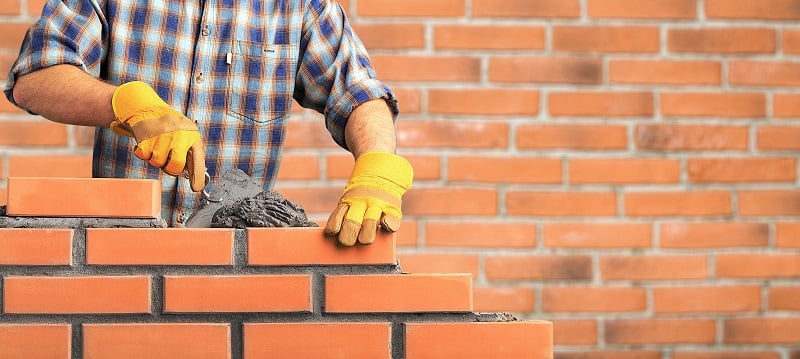Opening the Tricks of Lasting Masonry Building And Construction Practices for Eco-Friendly Buildings
Amongst the myriad methods to green building, sustainable stonework construction stands out as a tried and true and long lasting method that holds a riches of untapped possibility. From the choice of materials to ingenious building and construction techniques, the tricks to achieving sustainability within masonry building are complex and interesting.
Benefits of Sustainable Stonework Building And Construction
Accepting sustainable masonry construction techniques not just minimizes ecological effect however likewise offers lasting financial benefits to home builders and neighborhoods. By using materials like recycled bricks, obstructs, and rocks, contractors can substantially decrease the carbon impact of their tasks while promoting source effectiveness. Additionally, lasting masonry building methods, such as proper insulation and thermal mass properties, can boost power effectiveness within structures, causing decreased functional expenses with time.
Additionally, the longevity and strength of masonry frameworks add to long-term economic advantages. Buildings created utilizing lasting masonry techniques often call for much less maintenance and repair work, converting to cost savings for contractors and building proprietors. The durability of stonework materials likewise makes certain that structures remain stable and safe, reducing the requirement for constant remodellings or substitutes.
Eco-Friendly Stonework Products
Utilizing eco-friendly masonry materials is a critical action in the direction of enhancing the sustainability of construction methods and decreasing ecological impact while making the most of long-term economic advantages. Sustainable masonry products are sourced, generated, and made use of in a manner that decreases total environmental impact. Materials such as recycled bricks, recovered rock, and lasting cinder block are ending up being progressively preferred selections for eco-conscious home builders. Recycled bricks, for instance, not only draw away waste from landfills however additionally call for much less energy to create compared to new bricks. Recovered stone uses an unique visual allure while lowering the demand for brand-new quarrying. Sustainable concrete blocks incorporate recycled accumulations and might feature improved insulation residential or commercial properties, adding to energy efficiency in buildings.
Moreover, natural products like adobe, rammed planet, and straw bales give exceptional thermal mass residential or commercial properties, reducing the demand for heating and cooling down power. These materials are commonly in your area available, promoting regional economic climates and minimizing transportation-related carbon emissions. By picking eco-friendly stonework products, building and construction projects can significantly decrease their ecological footprint and contribute to the development of much healthier, a lot more sustainable developed settings.
Energy-Efficient Masonry Methods
Power efficiency plays an essential duty in enhancing the sustainability of masonry construction practices. One vital energy-efficient stonework method is the use of thermal mass, which entails integrating dense products like concrete or block into the building's structure electric cement mixer to absorb and store warm.

Innovations in Sustainable Stonework
Current innovations in sustainable stonework practices have produced ingenious methods that are improving the building and construction market. One such technology is the development of self-healing concrete, which utilizes germs installed within the concrete to recover fractures autonomously. This development not only decreases upkeep costs yet also modern concrete boosts the durability of stonework frameworks, contributing to their sustainability.
One more remarkable advancement is making use of recycled aggregates in stonework building and construction - masonry contractor. By incorporating materials such as crushed ceramic waste or recycled glass right into concrete mixes, home builders can minimize the ecological effect of construction tasks while preserving architectural integrity. This technique not only diverts waste from land fills however additionally conserves natural deposits, making it an essential innovation in sustainable stonework construction
Moreover, the assimilation of digital design devices, such as Structure Details Modeling (BIM), is reinventing the means stonework structures are intended and built. BIM enables more precise estimations, reduced material wastefulness, and boosted energy performance, inevitably causing more sustainable building methods. These innovations jointly signify an encouraging future for lasting masonry building in the era of environment-friendly structures.
Future Trends in Stonework Sustainability
With the cutting-edge strides made in sustainable stonework practices, the future trends in masonry sustainability are poised to more change the building market. One of the key patterns shaping the future of stonework sustainability is the enhanced integration of technology. Developments such as Structure Details Modeling (BIM) and digital truth simulations are being made use of to enhance masonry building processes, bring about lowered material waste and improved energy efficiency in structures.
Moreover, the advancement of unique sustainable products is readied to play a significant role in enhancing the eco-friendliness of masonry construction. masonry contractor. Innovations like self-healing concrete, decorative concrete floor finishes recycled aggregates, and bio-based binders are getting traction for their capacity to minimize environmental influence while preserving architectural stability

Verdict
Finally, lasting masonry building and construction techniques supply various advantages for eco-friendly buildings. By making use of green materials and energy-efficient techniques, masonry can add to an extra sustainable built atmosphere. Developments in sustainable stonework are continuously being created to even more improve the ecological performance of structures. Looking towards the future, the pattern of stonework sustainability is anticipated to grow, leading to more eco-friendly and energy-efficient building practices in the years to find.